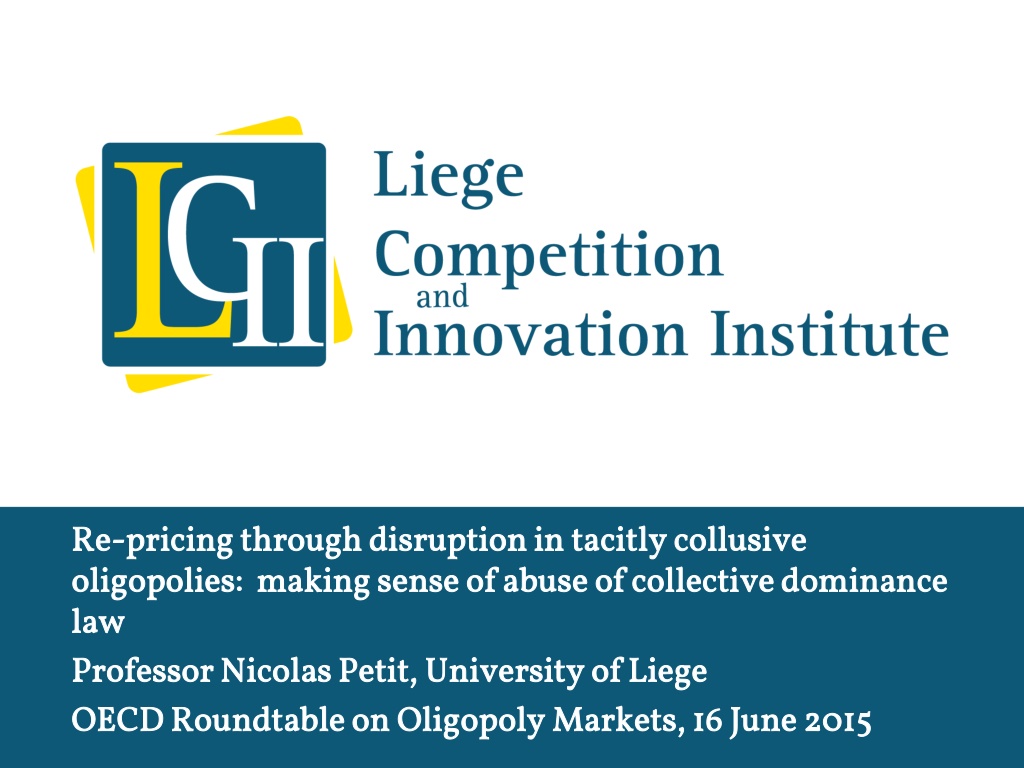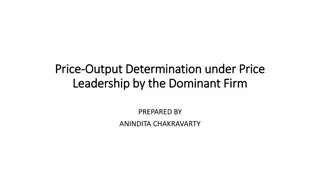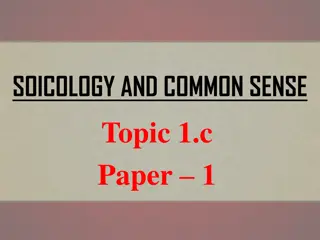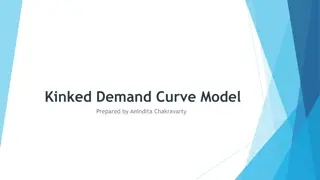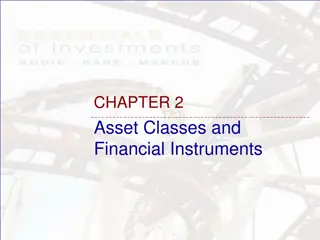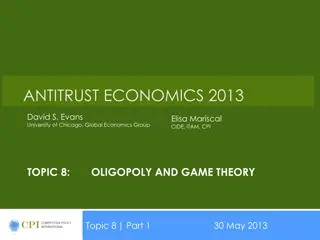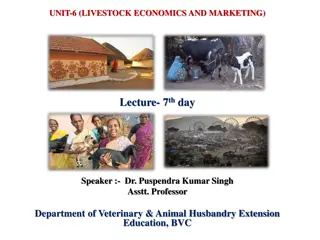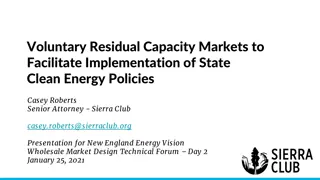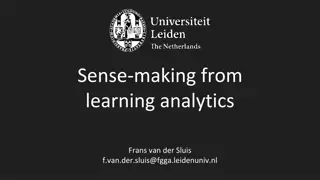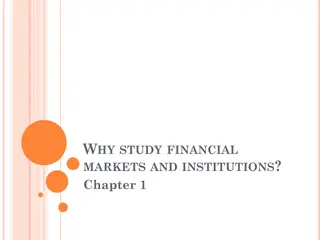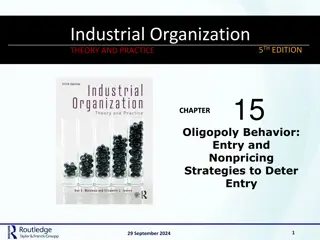Making Sense of Oligopoly Markets
In this presentation by Professor Nicolas Petit, the focus is on understanding collusive pricing and abuse of collective dominance in oligopolies. The discussion delves into the challenges of enforcement and liability under monopolization laws, presenting case studies and theoretical frameworks to shed light on the complexities of pricing strategies in such market structures.
Download Presentation

Please find below an Image/Link to download the presentation.
The content on the website is provided AS IS for your information and personal use only. It may not be sold, licensed, or shared on other websites without obtaining consent from the author.If you encounter any issues during the download, it is possible that the publisher has removed the file from their server.
You are allowed to download the files provided on this website for personal or commercial use, subject to the condition that they are used lawfully. All files are the property of their respective owners.
The content on the website is provided AS IS for your information and personal use only. It may not be sold, licensed, or shared on other websites without obtaining consent from the author.
E N D
Presentation Transcript
Re Re- -pricing through disruption in tacitly collusive pricing through disruption in tacitly collusive oligopolies: making sense of abuse of collective dominance oligopolies: making sense of abuse of collective dominance law law Professor Nicolas Petit, University of Liege Professor Nicolas Petit, University of Liege OECD Roundtable on Oligopoly Markets, 16 June 2015 OECD Roundtable on Oligopoly Markets, 16 June 2015
Goals of the presentation Case for more Case for more ex post collusion collusion Proposed Proposedtheory theoryof colldom colldom/ /shared sharedmonopolization Pros and cons Pros and cons Overview Overviewof of enforcement enforcementin EU (option) (option) ex post enforcement enforcementagainst againsttacit tacit of liability liabilityunder monopolization underabuse of abuse of in EU Member MemberStates States www.lcii.eu www.lcii.eu
1. The merger control blindspot The The merger mergermostly Trigger Trigger defused defusedin stable The Coca The Coca- -Cola/ Cola/PepsiCo mostlyparadigm paradigm in stable oligopolies PepsiCoimpossibility impossibility oligopolies www.lcii.eu www.lcii.eu
2. Re-pricing through disruption Fictional Fictionalexample Beer Beerduopoly duopoly, , with players players Collusive Collusive price AVC of 5$/gallon AVC of 5$/gallon Government Governmentintroduces 3$/gallon 3$/gallon Four possible Four possible re re- -pricing Full transfer 13$/gallon Full internalization of tax 10$/gallon Partial internalization of tax10- 13$/gallon Over internalization of tax 5-9$ per gallon Choice Choicenot not entirely entirelyamenable simple simple game gametheoretic theoretic framework framework Information, Information, urgency urgencyand readability readabilityof disruption of disruption example withsymmetric symmetric Real life illustrations Real life illustrations In the 1960s, introduction of In the 1960s, introduction of radial technology by Michelin in radial technology by Michelin in US US tyre tyreoligopoly oligopoly In the 1980s, entry of low cost In the 1980s, entry of low cost carriers on routes dominated by carriers on routes dominated by oligopoly airlines oligopoly airlines In 2011, entry of the company In 2011, entry of the company Free on the French mobile Free on the French mobile oligopoly oligopoly Change brought by digital Change brought by digital technologies and sharing technologies and sharing economy business models? economy business models? priceof 10$/gallon; of 10$/gallon; introducestax taxof of pricingoptions options amenableto to and lack lackof of www.lcii.eu www.lcii.eu
Proposed theory of liability Catch oligopoly practices adopted to restore collusive price equilibrium Catch oligopoly practices adopted to restore collusive price equilibrium post disruption post disruption Creation of subtle communication conduits Creation of subtle communication conduits B makes public statements that it is studying with its analysts the effects of a full transfer of the tax on retailers; A posts its new price on its Facebook timeline. A is friend with retailer Z. Z shares A s posts on its Facebook page. B is also friend with Z A to take a minority shareholding in B, so as to be informed of B s pricing strategy as an insider Change model, entry of 10 micro Change model, entry of 10 micro- -brewers who eat 10% of the brewers who eat 10% of the duopolists market share market share Selection of new price point, to maintain total profits on a 45% market share Attempted exclusion of micro-brewers will raise costs => necessity to re-price Collusive inducement of micro-brewers through threats and incentives duopolists www.lcii.eu www.lcii.eu
Framework Any disruption imposes on Any disruption imposes on oligopolists Oligopolists Oligopolistsmust avoid a facilitating practice caught by cartel must avoid a facilitating practice caught by cartel law law Space for abuse of collective dominance => Space for abuse of collective dominance => adaptative oligopolist oligopoliststrategy to re strategy to re- -price through disruption, and elude price through disruption, and elude its pro its pro- -competitive effect competitive effect Core evidentiary components, proof of ( Core evidentiary components, proof of (i i) a certain degree of existing collusion; (ii) disruption; (iii) re existing collusion; (ii) disruption; (iii) re- -pricing strategy; (iv) likely return to collusive equilibria likely return to collusive equilibria Typical example is unilateral signaling, but not limited to this Typical example is unilateral signaling, but not limited to this Parallel exclusion Parallel exclusion is possibility, though no priority? At any is possibility, though no priority? At any rate, should be restricted to disrupted contexts rate, should be restricted to disrupted contexts oligopoliststo re to re- -price price adaptative ) a certain degree of pricing strategy; (iv) www.lcii.eu www.lcii.eu
3. Pros and cons Type I v Type 2 Type I v Type 2 errors Disruption remainsa necessarytrigger But rationalizedapproach, whichkeepsthe theoryreasonably predictable Kills bogey man of transposition of single firmconductlawin oligopolymarkets Abuse v cartel Abuse v cartel law law? ? Problem with cartel law approach is not one of desirability, but of feasibility + problem of proof (Mezzanote, 2009) Yet another bogey man : ex post proof of tacit collusion is possible + documentary evidence; resilient idea Our approach focuses less on tacit collusion, and at any rate does not make it unlawful => possibility to apply a preponderance of the evidence standard of proof to tacit collusion Rationalized v open Rationalized v open- -ended abuse of collective dominance? ended abuse of collective dominance? Sports leagues disease errors www.lcii.eu www.lcii.eu
4. countries Overview of enforcement in EU Follow Followup of 2011 up of 2011 study E E- -competitions competitionsdatabase 9 relevant 9 relevant decisions decisions Merger Mergercases cases SeveralGermancases relatedto use of structural presumptionof CollDom Abuse of dominance cases Abuse of dominance cases No genuinecases of tacitcollusion Spain, wholesaletelephonesort messaging case, 2012: individually dominant positions of eachtelcooperatoron terminationmarket France, GIE Exploitation des carri res, 2012: price-fixing case, with sellingboycott treatedas abuse of collective dominance Not Not enough enoughto to draw drawconclusions conclusions studywith database withN. N. Neyrinck Neyrinck www.lcii.eu www.lcii.eu
Conclusion Rationalized, market Rationalized, market- -triggered, case collective dominance theory of liability collective dominance theory of liability For more, see (2012), The Oligopoly Problem in EU Competition Law , For more, see (2012), The Oligopoly Problem in EU Competition Law , Research Handbook in European Competition Law Research Handbook in European Competition Law, I. Geradin Geradineds., Edward Elgar, September 2013 eds., Edward Elgar, September 2013 triggered, case- -law proof and predictable abuse of law proof and predictable abuse of , I. Liannos Liannosand D. and D. www.lcii.eu www.lcii.eu
Follow me on twitter @CompetitionProf Papers available@ http://papers.ssrn.com/sol3/cf_dev/AbsB yAuth.cfm?per_id=358753 Liege LiegeCompetition Competitionand Innovation Institute (LCII) and Innovation Institute (LCII) University of Liege(ULg) Quartier Agora | Place des Orateurs, 1, B t. B 33, 4000 Liege, BELGIUM
